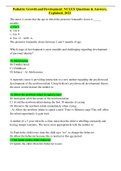Exam (elaborations)
NCLEX Questions & Answers | Pediatric Growth and Development: , Explained, 2022
- Course
- Institution
NCLEX Questions & Answers | Pediatric Growth and Development: , Explained, 2022-The nurse is aware that the age at which the posterior fontanelle closes is _____ months. a. 2 to 3 b. 3 to 6 c. 6 to 9 d. 9 to 12 - ANS: A The posterior fontanelle closes between 2 and 3 months of age. Which...
[Show more]



